A customer journey map is a visual representation of the process a customer goes through to achieve a goal with your company.
It details the customer’s interactions with your brand across multiple touchpoints, highlighting their needs, emotions, and experiences. Customer journey maps help businesses understand their customers’ perspectives, identify areas for improvement, and create a more seamless and satisfying customer experience.
It also plays a pivotal role in aligning business operations with the expectations of customers, leading to enhancements in product or service design, marketing approaches, and overall business efficiency.
According to Gartner, customer journey maps only bring value when they’re used to inform business priorities. Simply creating a map is not enough – it must be integrated into business strategies and decision-making processes.
Ultimately, a meticulously designed customer journey map fosters a culture centered around the customer, driving long-term business prosperity.
This article will explore:
- The basics of customer journey maps
- How to create a customer journey map
- How can customer journey maps improve customer experiences?
- How can a DAP enhance customer journey mapping?
What is a customer journey map?
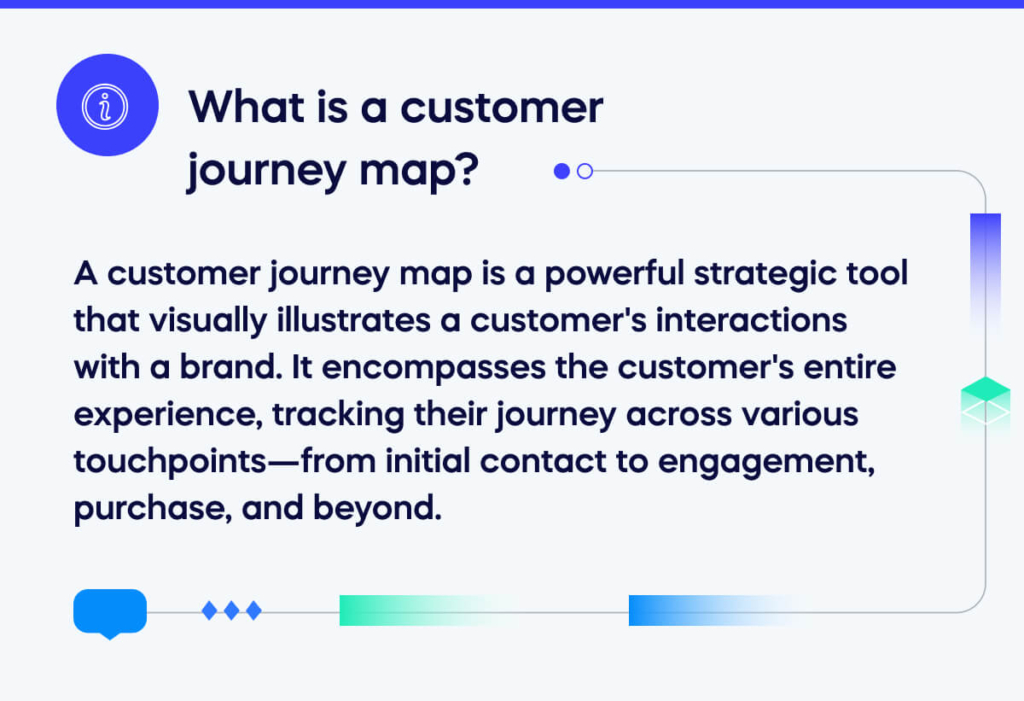
Let’s start with a clear-cut definition:
A customer journey map is a powerful strategic tool that visually illustrates a customer’s interactions with a brand. It encompasses the customer’s entire experience, tracking their journey across various touchpoints—from initial contact to engagement, purchase, and beyond.
This map provides valuable insights by delving into the customer’s needs, emotions, and experiences at each stage. It also highlights potential obstacles and opportunities for improvement. With the help of this map, businesses can elevate customer satisfaction, align their operations with customer expectations, and drive overall business growth.
Ultimately, a customer journey map is a guiding compass for creating exceptional customer experiences, fostering a customer-centric culture vital for long-term success.
Why is a customer journey map important?
A customer journey map serves as a strategic blueprint for businesses, enabling them to gain deep insights into their customers’ experiences and expectations.
By understanding, identifying, and addressing the customer’s needs and pain points, businesses can improve product/service design, optimize marketing strategies, boost overall business performance, and foster a customer-centric culture.
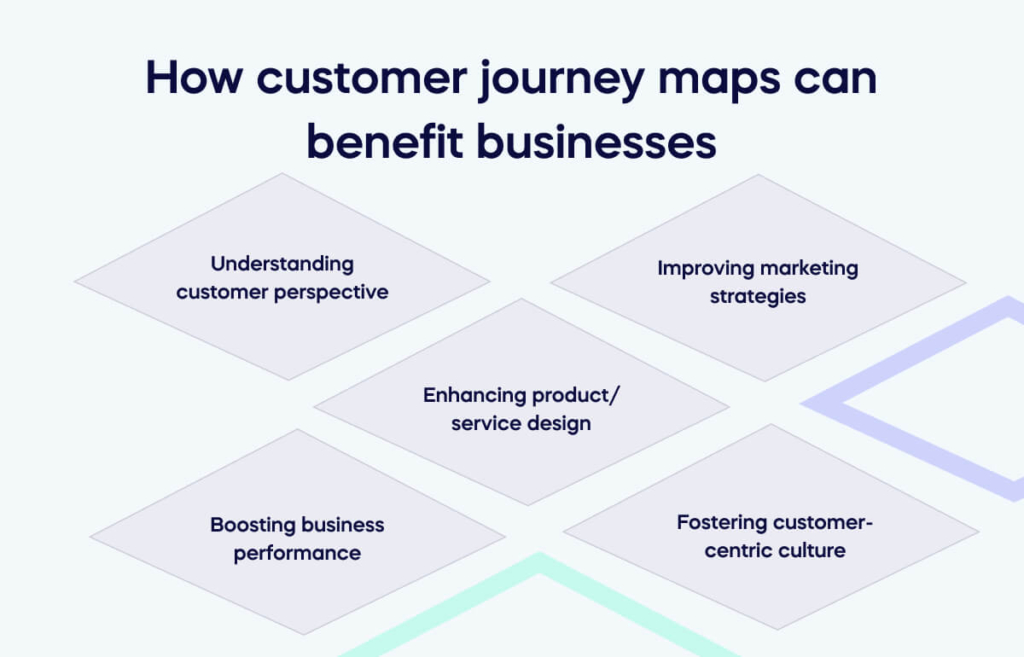
Let’s take a closer look at how customer journey maps can benefit businesses:
Understanding customer perspective: A customer journey map provides a comprehensive overview of how customers interact with a business. It captures the customer’s experience from their point of view, tracing their path from initial contact through to the point of purchase and beyond. This allows businesses to truly understand what motivates their customers, what their needs are, and what their experiences are like.
Enhancing product/service design: Insights gained from the customer journey map can significantly inform the design or redesign of products or services. By understanding what customers need and want, businesses can tailor their offerings to meet these needs and expectations, increasing customer satisfaction and loyalty.
Improving marketing strategies: The journey map can inform more effective and targeted marketing strategies. It can reveal what information customers are looking for at different stages of their journey, allowing businesses to deliver the right message at the right time. This can not only increase customer engagement but also conversion rates.
Boosting business performance: Ultimately, a deep understanding and improvement of the customer journey can significantly boost business performance. Satisfied customers are more likely to be repeat customers and more likely to recommend the business to others. Both factors can lead to increased sales and growth for the company.
Fostering customer-centric culture: Creating a customer journey map requires a business to think deeply about the customer’s perspective, fostering a culture that puts the customer at the heart of everything the company does. This customer-centric culture is key to long-term business success as it ensures all business decisions are made with the customer’s best interests in mind.
How to create a customer journey map
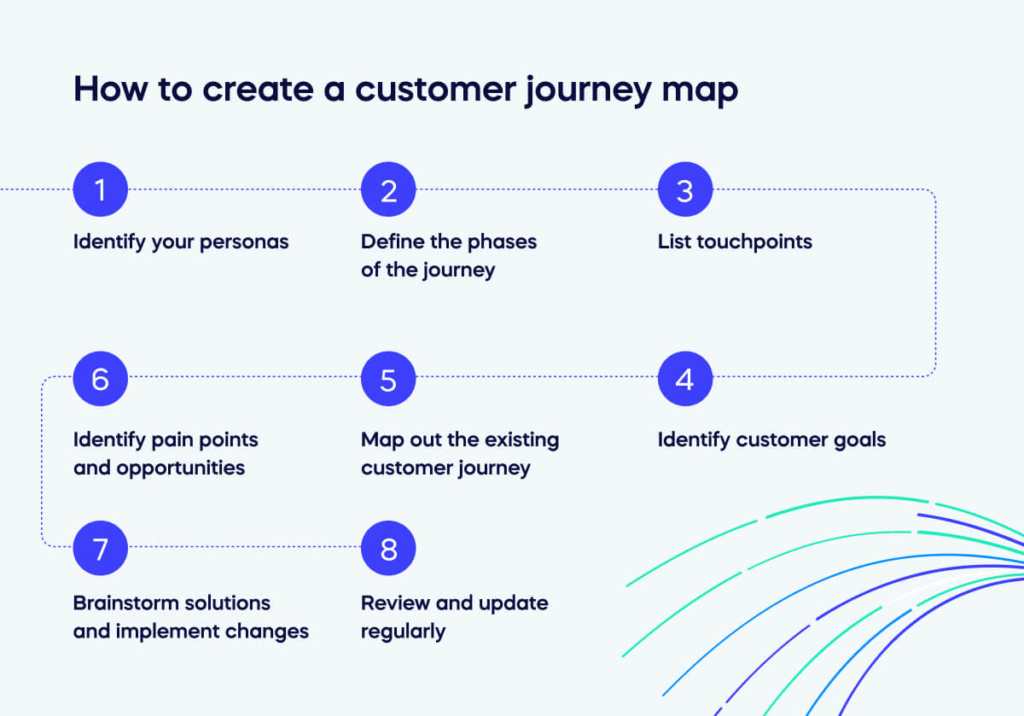
Creating a customer journey map is essential for businesses aiming to understand and enhance the customer experience.
It involves several strategic steps, from identifying your customer personas to regularly reviewing and updating the map. Each plays a crucial role in ensuring a comprehensive understanding of your customer’s interactions with your business.
Let’s take a closer look:
Identify your personas
This crucial step entails conducting a comprehensive analysis of your customer base.
To achieve this, you must employ various methods, such as conducting customer surveys, interviews, and extensive market research. The objective is to meticulously identify and understand the key characteristics of your customers, including their demographics, behavior patterns, motivations, preferences, and goals.
By gathering this invaluable information, you can develop detailed and insightful personas that serve as fictional representations of your ideal customers, enabling you to tailor your strategies and offerings to meet their specific needs and desires.
Define the phases of the journey
Every customer journey can be broken down into different stages or phases. These typically include awareness, where customers discover your company or product and start to become familiar with it. Then comes the consideration stage, where they evaluate your product against others, comparing features, benefits, and pricing. After careful consideration, customers move on to the purchase stage, where they make the decision to buy, completing the transaction.
But the journey doesn’t end there. The next stage is retention, where customers continue to engage with your brand, becoming loyal customers who keep coming back for more. This stage is crucial for building long-term relationships and fostering customer loyalty.
Finally, we have advocacy, where satisfied customers become your brand ambassadors, promoting your product to others through word-of-mouth, reviews, and social media.
Understanding these stages from the customer’s perspective is key to gaining a clear picture of their experience with your company. Analyzing each stage in detail lets you identify pain points, optimize customer interactions, and ultimately enhance the overall customer journey.
List touchpoints
Touchpoints are vital touchstones that encompass all the myriad ways a customer engages with your company. These touchpoints can take various forms, encompassing both digital and physical realms.
For instance, digital touchpoints may include visiting your website, receiving personalized emails, or interacting with your brand on social media. On the other hand, physical touchpoints involve stepping into a brick-and-mortar store or conversing with a knowledgeable sales representative.
Meticulously mapping out these touchpoints provides a comprehensive understanding of how customers navigate their journey, highlighting potential hurdles. This invaluable insight paves the way for the identification and rectification of any issues, thereby ensuring a seamless and satisfying customer experience from start to finish.
Identify customer goals
At each stage of the customer journey, it is crucial to understand what the customer is trying to achieve. Are they seeking specific information to make an informed decision? Are they looking to make a purchase and require assistance choosing the right product? Or perhaps they are seeking support to resolve an issue or answer a question.
Gaining a deep understanding of these goals enables the effective service of customers, ensuring they can effortlessly accomplish what they set out to do. This involves providing relevant information, personalized recommendations, and a seamless support experience tailored to their needs.
Anticipating and addressing their specific goals enhances customer satisfaction and fosters long-lasting relationships.
Map out the existing customer journey
This involves meticulously detailing the current customer experience by thoroughly examining their actions at each stage. It also entails thoroughly exploring the thoughts and emotions they might experience and carefully identifying any obstacles they encounter along the way.
Diligently crafting this comprehensive map based on real data and profound insights ensures its accuracy and reliability, negating the need to rely on mere assumptions. Undertaking these meticulous steps provides a deeper understanding.
Identify pain points and opportunities
Careful examination of the customer journey map offers valuable insights into the various touchpoints and interactions that customers have with your business. This analysis identifies specific areas where customers may encounter challenges or frustrations, presenting crucial opportunities for improvement and optimization.
Specifying the pain points enables a deeper understanding of the underlying causes, leading to the development of targeted solutions that enhance customer satisfaction. Conversely, identifying aspects of the customer journey that bring delight and joy is equally important. These positive experiences can further enhance and elevate the overall customer experience, fostering loyalty and advocacy.
A thorough examination of the customer journey map empowers businesses to proactively address pain points, optimize touchpoints, and create delightful experiences that leave a lasting positive impression on customers.
Brainstorm solutions and implement changes
Once you’ve identified areas for improvement, gather your team together to brainstorm potential solutions and encourage everyone to share their ideas and perspectives.
This collaborative process can involve simplifying a complex process, enhancing a product feature based on customer feedback, or investing in comprehensive customer service training to improve customer satisfaction.
After careful consideration, select the most promising ideas and create an actionable plan for their implementation. Closely monitor the impact of these changes, gather feedback, and make necessary adjustments as needed. A thoughtful and proactive approach drives meaningful improvements and paves the way for long-term success.
Review and update regularly
Customer preferences and market conditions are constantly changing.
Effectively managing and enhancing your customer experience necessitates regular reviews and updates of your customer journey map. This ensures its accurate representation of the ever-evolving landscape of your customers’ interactions with your business.
A comprehensive approach allows for continuous optimization of your strategies, keeping you one step ahead of the ever-changing needs and expectations. Focusing on the finer details and consistently fine-tuning your customer journey map cultivates stronger relationships and propels long-term success.
How can customer journey maps improve the customer experience?
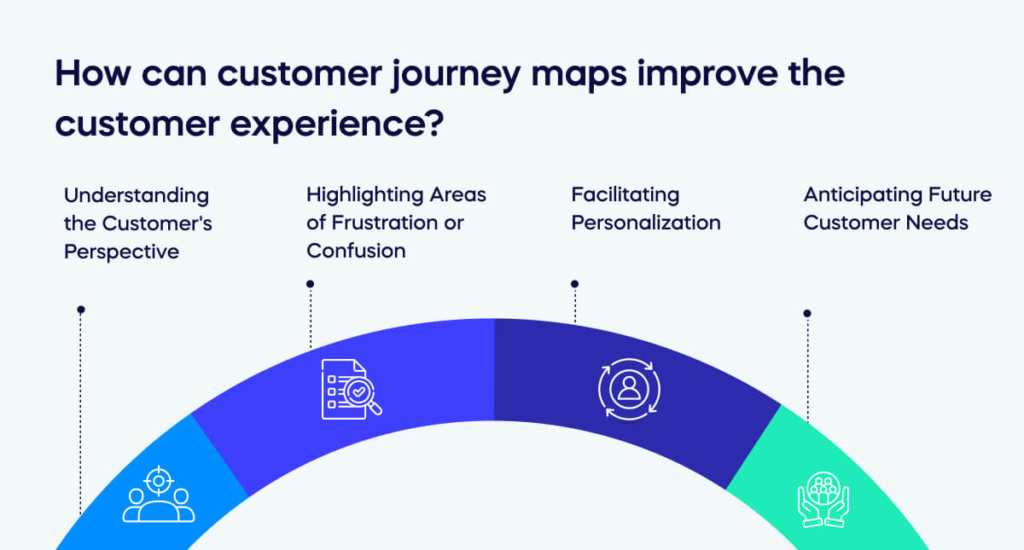
Customer journey maps are essential tools for enhancing the overall customer experience.
They visually represent a customer’s interactions with a company, offering valuable insights into their needs, preferences, and pain points.
Let’s take a look at how customer journey maps can improve the customer experience:
- Understanding the Customer’s Perspective: Customer journey maps allow businesses to view their operations from the customer’s viewpoint. This understanding enables enterprises to identify areas for improvement, optimize touchpoints, and ensure customer needs are met at every stage.
- Highlighting Areas of Frustration or Confusion: Journey maps pinpoint where customers may experience difficulties. Businesses can proactively address these issues, enhancing the customer experience and boosting satisfaction.
- Facilitating Personalization: Customer journey maps enable tailored services and communications, meeting each customer’s specific needs. Understanding the different stages of the customer journey results in a more personalized and enjoyable experience.
- Anticipating Future Customer Needs: These maps enable businesses to anticipate future customer needs by analyzing trends and patterns in the customer journey. This foresight allows companies to predict what customers want or need, helping them stay ahead of the competition.
How can a DAP enhance customer journey mapping?
Understanding your customer’s journey is crucial for a great user experience.
A Digital Adoption Platform (DAP) can enhance this process significantly. It offers insights into user behavior, identifies pain points, enables personalized experiences, and provides a platform for implementing and evaluating improvements.
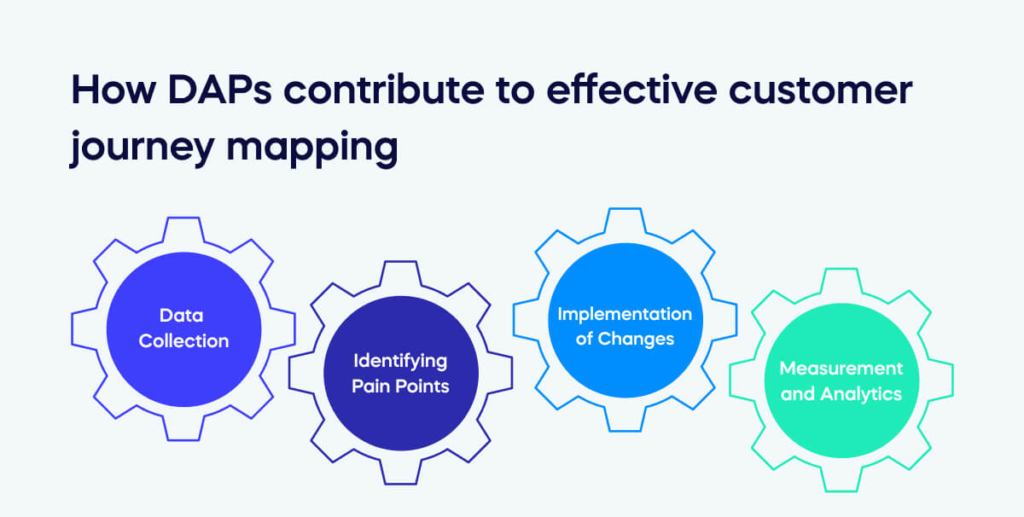
Let’s explore how DAPs contribute to effective customer journey mapping:
- Data Collection: DAPs provide valuable data on user behavior, including which features are most used, where users encounter difficulties, and where they tend to drop off. This data is crucial for creating a more accurate customer journey map.
- Identifying Pain Points: By tracking user interactions with your platform, DAPs can help identify areas where customers struggle, allowing you to pinpoint the exact stages in the journey that need improvement.
Personalization: DAPs can personalize the user experience, providing guidance and support based on individual user behaviors. This can be reflected in your customer journey map to create more personalized touchpoints. - Implementation of Changes: Once you’ve identified areas for improvement in the customer journey, a DAP can help implement those changes user-friendly. For example, it can introduce new features or processes to users through guided walkthroughs.
- Measurement and Analytics: DAPs provide analytics to measure the impact of changes you’ve made, providing real-time feedback on whether your improvements enhance the customer journey as intended.
I’ve created my customer journey map: What’s next?
Once you’ve created, tested, and implemented your customer journey map, you must review and update it regularly.
You might also consider creating different maps to represent the unique journeys of different customer segments.
But remember to always keep your customers’ needs and preferences at the forefront when making any changes or updates.
The last thing you want is to lose sight of your customer’s perspective and end up with an inaccurate or outdated map.
A customer-centric mindset will ensure the success and effectiveness of your customer journey map in enhancing the overall customer experience. So, continue collecting feedback, monitoring trends, and fine-tuning your strategies for long-term success.


